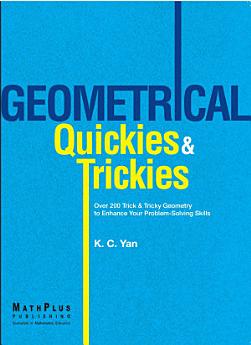Geometrical Quickies & Trickies
About this ebook
Some benefits of Geometrical Quickies & Trickies are:
* Over 200 non-routine geometry questions to separate the nerd of mathletes from the herd of drill-and-kill specialists;
* Trick and tricky questions to meet the mathematical needs and wants of students- and teachers-problem solvers;
* Twenty enrichment geometry units to promote an appreciation for recreational mathematics;
* Hints and solutions, and a reference list for more practice on quickies and tricks.
Geometrical Quickies & Trickies is suitable for grades 6-9 problem solvers and mathletes, and for teachers and tutors who desire to challenge (or torture) their students mathematically.
Contents
1. What is a Circle?
2. Three Famous (or Notorious) Geometrical Problems
3. Non-Euclidean Geometry for Goondus
4. How Many Regions?
5. That Holy Little Geometry Book
6. Fun with Areas and Perimeters
7. Always a Parallelogram!
8. The Malfatti's Problem
9. The Beauty of Pi
10. The Zero Option
11. The Golden Ratio by Paper Folding
12. The Ubiquity of Phi
13. Matchstick Mathematics
14. The Rolling Circle Question
15. Two Useful Circle Properties
16. Proving the Obvious
17. Sanguku—Japanese Temple Geometry
18. Applications of Pythagorean Theorem
19. Visualizing Infinity
20. Geometrical Idiosyncrasies
Answers/Hints/Solutions
Bibliography & References
About the author
Yan Kow Cheong ([email protected] and @MathPlus) is a math coach, writer, and editor. A math consultant for MathPlus Consultancy, he specializes in both adult and recreational math education. He has ghostwritten and edited both local and foreign textbooks and supplementary titles for students, teachers, and parents.
Some of his publications are "Additional Maths 360," "Mathematical Quickies & Trickies," "Aha! Math," and "CHRISTmaths: A Creative Problem Solving Math Book." He also wrote the popular US series "Primary Mathematics Challenging Word Problems Grades 1-6", published by Marshall Cavendish. His forthcoming titles are: "What's Wrong? A Comedy of Mathematical Errors" and "Who Took My Calculator?".
His academic interests involve research in math education, in particular, the psychology of learning and teaching mathematics, adult mathematics, and creative problem solving. He is a life member of both the Singapore Mathematical Society and the Association of Mathematics Educators. He is also a member of The Association of Christians in the Mathematical Sciences.








